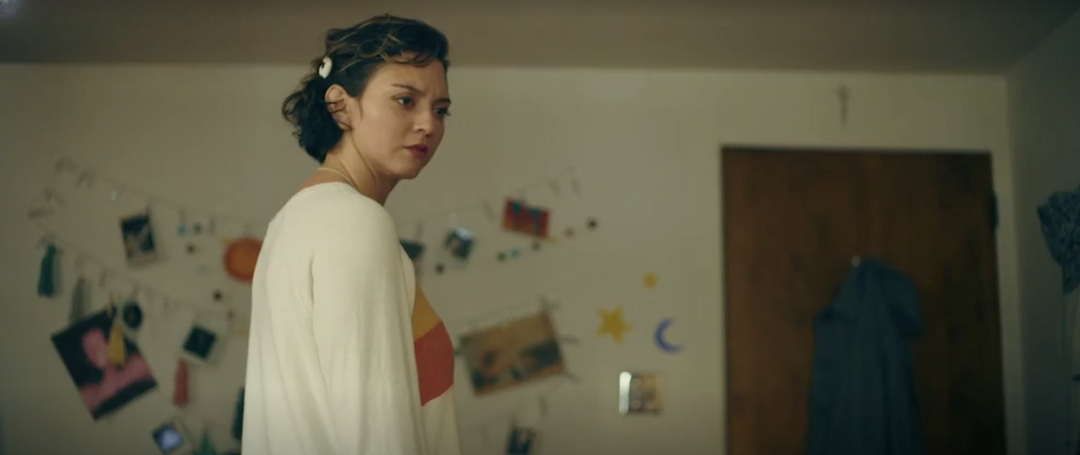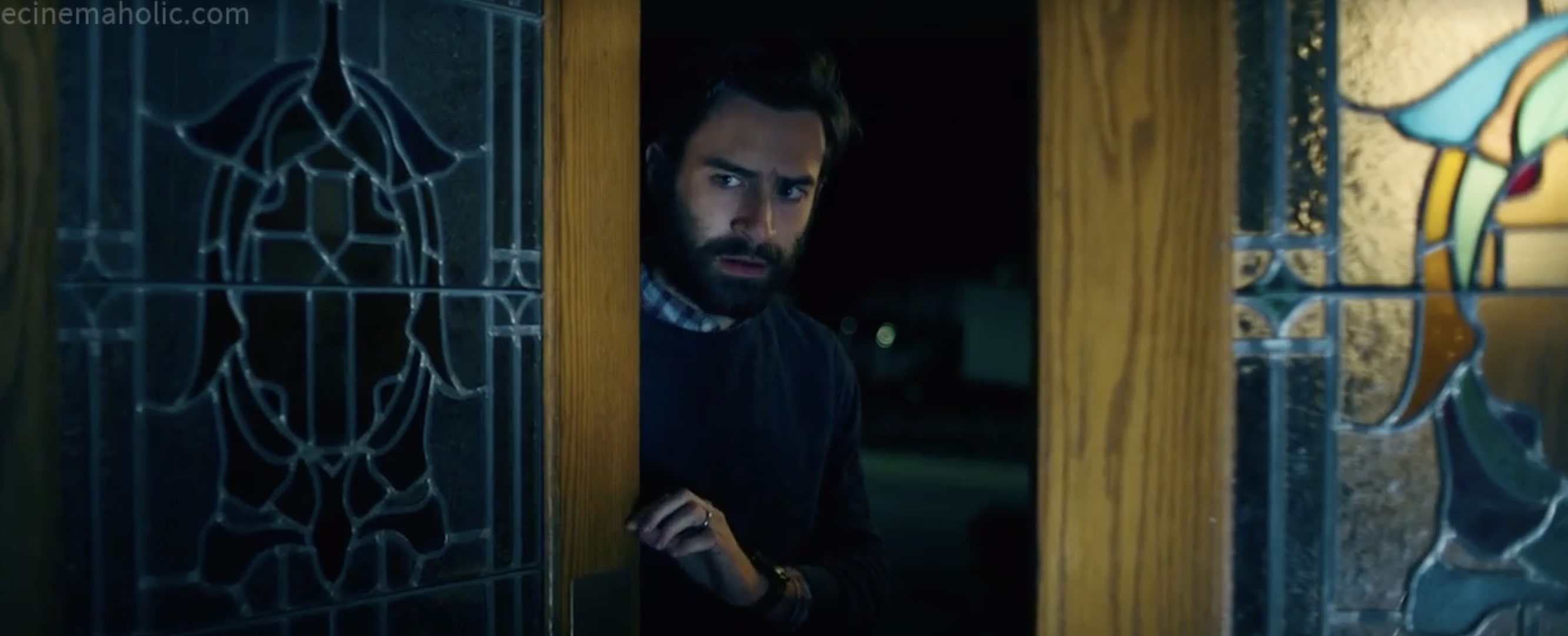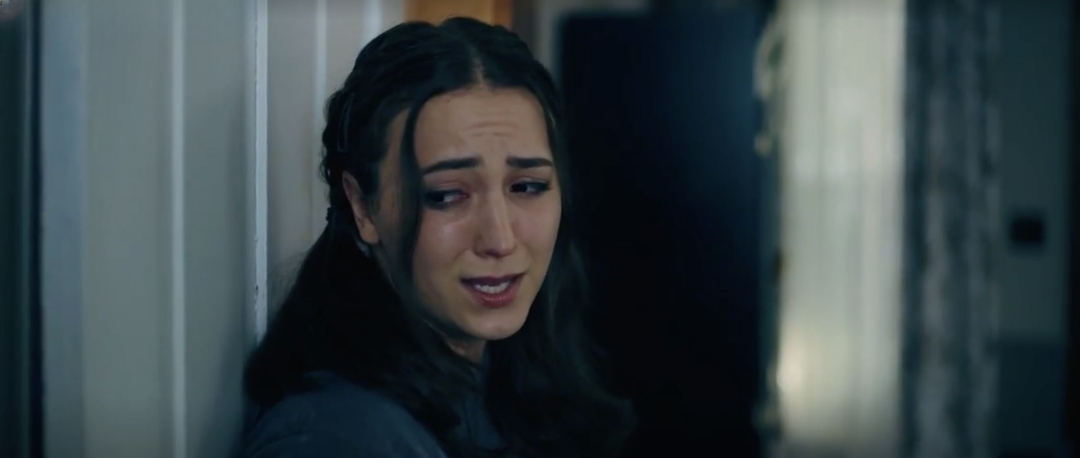Directed by Stephen Cognetti, the Shudder movie ‘825 Forest Road’ culminates in a chilling and deeply unsettling finale that lingers long after the credits roll. In the climactic moments, Chuck Wilson and his younger sister Isabel Wilson finally arrive at the cursed residence where the vengeful spirit of Helen Foster resides. However, their confrontation with the haunted Helen spirals into chaos, leaving their fates ominously unresolved. Meanwhile, Maria, who had been recounting her experience to those responsible for selling the Wilson family the house, succumbs to possession — adding another layer of terror to an already harrowing tale. The film’s ending is deliberately ambiguous and pessimistic, leaving viewers with far more questions than answers and solidifying its place as a haunting exploration of despair and supernatural malevolence. SPOILERS AHEAD.
825 Forest Road Plot Synopsis
The horrors of ‘825 Forest Road’ are set in motion by the tragic fate of Ashley, the first to encounter the wrath of the restless spirit, Helen Foster. Ashley is determined to uncover the truth about Ashland Falls and Helen’s cursed legacy. Her curiosity leads her to search for Helen’s original home, but she tragically dies after being targeted by Helen’s spirit. This sets the tone for the film, establishing Ashland Falls as a town consumed by supernatural terror.

The narrative then shifts to the Wilson family—Chuck, his wife Maria, and his younger sister Isabel—who move to Ashland Falls in hopes of starting fresh after a devastating family tragedy. The movie unfolds in four distinct chapters: Chuck, Isabel, Maria, and finally, Forest Road, each focusing on different aspects of their experiences and unraveling the mystery surrounding Helen Foster. At first, Chuck is introduced as the driving force behind the family’s relocation to Ashland Falls. He hopes that moving away from the city will help Isabel recover from her emotional struggles following their mother’s death in a car accident. Chuck quickly realizes that Ashland Falls is not the peaceful refuge he envisioned. Strange occurrences begin to plague their new home, and Chuck becomes obsessed with finding Helen Foster’s original residence, believing it to be key to ending the hauntings.
Isabel’s chapter delves into her fragile mental state and her struggles with guilt over her mother’s death. Her vulnerability makes her an easy target for Helen’s spirit. Supernatural events intensify around Isabel, mostly during her dreams, including terrifying encounters with her mother’s vengeful ghost. In one chilling scene, her mother’s spirit drops crockery and terrifies Isabel, amplifying her feelings of guilt and isolation. Chuck reassures her that she isn’t responsible for their mother’s death, but Isabel remains unconvinced.
Maria’s chapter focuses on her possession of Helen Foster’s spirit. Maria initially appears stable despite struggling with bipolar disorder, but as Helen’s influence grows stronger, Maria begins exhibiting erratic behavior. In the final chapter, Chuck and Isabel uncover clues leading them to what they believe is 825 Forest Road. Upon entering the house, Chuck discovers letters written by Helen Foster revealing that her actual address was something else, leaving him in a state of deep shock. The film ends on a pessimistic note with no resolution or escape for the Wilson family. The haunting persists as a manifestation of unresolved trauma and vengeance, leaving audiences immersed in its chilling ambiguity.
825 Forest Road Ending Explained: Do the Wilson Family Members Die?
At the end of ‘825 Forest Road,’ Chuck and Isabel finally pinpoint the location of 825 Forest Road with Luke’s help. Resolute in their mission to end the torment that has plagued their family, they embark on a journey to confront the source of the haunting. Their determination is fueled by desperation, as they believe this confrontation will bring closure to their suffering. However, what follows is a chilling and ambiguous sequence that leaves their fate hanging in uncertainty. Upon arriving at the house, Chuck and Isabel are met with an unsettling atmosphere. The structure is decrepit and foreboding, its walls cracked and covered in grime, exuding an ominous presence that seems to grow stronger with every step they take. As they cautiously enter, the house feels alive with tension—its silence broken only by the creaking of floorboards beneath their feet. The siblings begin their search for answers, navigating through darkened hallways and rooms that seem frozen in time.

Their exploration leads them to a small room cluttered with forgotten belongings and scattered papers. In this room, Chuck discovers a box containing letters written by Helen Foster. These letters are desperate pleas for help sent to the Clark Family before her tragic death. As Chuck reads through them, he uncovers a shocking revelation: the address tied to Helen’s haunting is not 825 Forest Road but 15 Rose Lane—the very house they have been living in all along. Moreover, the 825 Forest Road is not actually Helen’s but the Clark Family’s, the tormentors of Helen. This realization sends a wave of dread through Chuck as he begins to connect the dots about the inexplicable force that has been targeting his family.
Before Chuck can fully process this discovery or share it with Isabel, the room’s atmosphere shifts dramatically. A sudden chill fills the air, and Isabel lets out a terrified scream as an unseen force grabs her arm. Chuck turns to see his sister being dragged backward by an invisible hand, her struggles futile against the overpowering grip. He lunges forward to save her, grabbing her arm and pulling with all his strength. However, his efforts are in vain as the force overtakes him as well. Both siblings are pulled into the shadows of the room, disappearing from view as their screams echo through the house.
The film cuts away at this moment, leaving their ultimate fate ambiguous but heavily implying that they succumbed to supernatural forces. Meanwhile, Maria’s storyline unfolds in parallel during this climactic sequence. While Chuck and Isabel confront their fate at 825 Forest Road, Maria is seen giving testimony about her family’s experiences to a group that includes the representatives from the agency that sold them the house. Moreover, Isabel’s boyfriend Luke is also present there. Her voice becomes ghostly and distorted, and her nose starts bleeding—a clear sign that Helen’s spirit has taken full control of her.
As Luke asks if she is okay, Maria snaps violently under Helen’s possession. In a horrifying outburst, she likely kills everyone present in the room, including Luke and those conducting the testimony. The film ends ambiguously regarding Maria’s fate but strongly suggests that she has become a vessel for Helen’s spirit, continuing her cycle of terror unchecked. In the end, Chuck and Isabel vanish into darkness during their confrontation at 825 Forest Road, while Maria succumbs entirely to possession during her testimony—leaving destruction in her wake.
Who is Helen Foster? Why Did She Take Her Own Life?
Helen Foster is the central figure in the haunting of ‘825 Forest Road,’ a vengeful spirit whose tragic life and death have cursed the town of Ashland Falls for decades. Her story began in the 1940s when she lived at 15 Rose Lane (later misattributed as 825 Forest Road) with her daughter Mary. Helen’s life was marked by hardship, but it was Mary’s suffering that ultimately pushed her into despair. Mary, a kind but introverted girl, became the target of relentless bullying at school. The torment escalated to such an extent that it left deep emotional scars on her. Helen, as a protective mother, tried everything in her power to intervene. She wrote numerous letters to school officials, local authorities, and even to the parents of the bullies—the Clark family—pleading for help and demanding action to stop the abuse. However, her cries for help were ignored and dismissed as overreactions by a single mother in a small town unwilling to confront its darker truths.

The situation reached its breaking point when Mary, unable to endure the constant torment any longer, took her own life. This devastating loss shattered Helen completely. The grief and rage she felt over losing her daughter were compounded by the indifference of those who could have prevented it. In her anguish, Helen turned to violence. Consumed by fury, she murdered the Clark family in their home before turning the shotgun on herself. Helen’s death marked the beginning of a dark chapter for Ashland Falls. Her spirit remained tethered to the town, fueled by unresolved rage and sorrow. Over time, Helen’s ghost became an ominous presence tied to unexplained suicides and disappearances in the area. The town attempted to erase her memory by redrawing boundaries and renaming streets, effectively hiding 15 Rose Lane (falsely believed to be 825 Forest Road) from maps and public records. Despite these efforts, Helen’s malevolent influence persisted.
What makes Helen’s haunting particularly disturbing is how misdirected her vengeance becomes. Instead of targeting those who perpetuate harm or bullying, Helen focuses on individuals struggling with mental health issues—perhaps because they remind her of Mary’s pain or because they are easier to manipulate. This twisted fixation turns Helen into a force of destruction rather than justice. Helen’s story is one of profound tragedy and misplaced anger. Her inability to move on from her grief traps her spirit in an endless cycle of vengeance that drags others into despair.
The Wilson family becomes her latest victims after unknowingly moving into a house tied to her legacy. Chuck’s discovery of Helen’s letters reveals not only her desperate attempts to save Mary but also the true location of her home at 15 Rose Lane—a revelation that comes too late to save his family from Helen’s wrath. It is fair to say that Helen Foster is both a victim and a villain—a mother whose love for her daughter drove her to unimaginable extremes but whose unresolved trauma continues to wreak havoc long after her death. Her story showcases the devastating consequences of neglecting those in need and how unaddressed pain can fester into something far more dangerous.
Why Does Helen Foster Haunt Ashland Falls People?
Helen Foster’s haunting of Ashland Falls is driven by a complex mix of motivations that are both tragic and misguided. Her spirit targets individuals who are struggling with mental health issues, a pattern that seems to be linked to her own daughter’s tragic fate. This fixation on those who are vulnerable suggests that Helen seeks to inflict suffering similar to what her daughter endured, perpetuating a cycle of trauma and despair. Helen’s choice of victims appears to be based on their susceptibility to her influence. She preys on those who are already grappling with mental health challenges, such as depression and bipolar disorder. This is evident in her targeting of Isabel, who struggles with depression, and Maria, who has bipolar disorder. By exploiting their vulnerabilities, Helen is able to manipulate and control them more easily, using them as vessels for her cursed spirit.

The case of Ashley, a young girl who attempted to locate Helen’s house, also fits this pattern. Ashley’s determination and curiosity about the town’s dark past likely made her a target for Helen’s wrath. Her tragic fate serves as a warning to others who might try to uncover the truth about Helen’s haunting. Helen’s motivations go beyond revenge against those who wronged her daughter. Instead, her actions become a twisted attempt to replicate the pain and suffering she feels, ensuring that others experience the same despair she has endured. This misdirected vengeance turns Helen into a force of destruction rather than justice, leaving a trail of terror and tragedy in her wake. We can say that Helen’s haunting of Ashland Falls is a manifestation of her unresolved grief and anger, which continues to claim victims long after her death. Her spirit remains trapped in a cycle of vengeance, perpetuating a dark legacy that refuses to be silenced.
What Happened to Isabel’s Mother?
Isabel’s mother’s tragic death is a pivotal element of her story in ‘825 Forest Road,’ shaping Isabel’s mental state and fueling the supernatural events that follow. It is revealed that Isabel’s mother died in a car accident caused by Isabel herself, an incident that Isabel has never been able to forgive herself for. This guilt becomes a central part of her character, driving her isolation and vulnerability throughout the film. The accident occurred when Isabel, distracted or inexperienced, lost control of the vehicle while driving with her mother. The crash resulted in her mother’s death, leaving Isabel overwhelmed with grief and self-blame. Despite Chuck’s reassurances that it wasn’t her fault, Isabel holds herself entirely responsible for the tragedy. This unresolved guilt manifests in her fragile mental state, making her more susceptible to the supernatural forces tied to 15 Rose Lane.

After the family moves into 15 Rose Lane to escape the city and provide Isabel with a fresh start, her mother’s vengeful spirit begins to haunt her. In Chapter 3: Isabel, we see her mother’s ghost dropping crockery in the house and terrifying Isabel with its presence. These incidents are not random; they seem to be deliberate acts meant to torment Isabel and remind her of the accident. The spirit appears as an embodiment of Isabel’s guilt, amplifying her feelings of responsibility for her mother’s death. The haunting escalates as Isabel becomes increasingly unstable. Her mother’s spirit grows more aggressive, targeting Isabel directly with chilling encounters that blur the line between reality and hallucination.
These moments suggest that the spirit is not merely a manifestation of guilt but an actual vengeful entity seeking retribution for its untimely death. The supernatural events surrounding Isabel push her further into despair, making her an easy target for Helen Foster’s chilling influence later in the film. Isabel’s mother’s haunting serves as a symbolic representation of unresolved trauma and guilt. It highlights how unaddressed emotional wounds can leave individuals vulnerable to external forces—both psychological and supernatural. The family’s decision to move to 15 Rose Lane was meant to help Isabel heal, but it inadvertently placed them in Helen Foster’s domain, compounding their suffering.
Read More: The Rule of Jenny Pen Ending Explained


